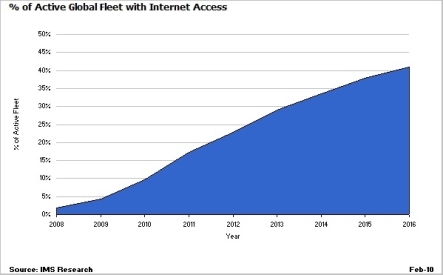In-flight Wi-fi will start to make money for airlines around the middle of this decade, when over 35% of the active global commercial fleet is expected to be equipped with systems to support such service, IMS Research reports in a new market study.
"Initially, the revenue generated by in-flight connectivity systems will be used to pay off the purchase of the hardware. But, what we understand from airlines [is] they will be able to make that money in five to six years, and beyond that there will be profit," IMS Research market analyst, automotive and transportation group Parmjit Bhangal tells ATI.
"That's the optimistic forecast that the airlines have spoken to us about."
At the end of 2009, nearly 700 aircraft in the US domestic fleet were equipped with Aircell's air-to-ground (ATG)-based in-flight Wi-fi solution, while a growing roster of airlines in Asia, Europe and the Middle East had adopted offerings supported by Inmarsat L-band satellites, including GSM/GPRS mobile phone service and light Internet.
High-speed Internet offered over Ku-band satellites has also recently attracted some large customers, including Southwest Airlines for Row 44's system, as well as Lufthansa and Turkish Airlines for Panasonic Avionics' system. More carriers are expected to follow suit.
IMS Research estimates that over 35% of the global commercial fleet will offer in-flight Internet by 2015.

"This is a reflection of how the airline industry is noting the on-ground popularity, and need, for access on the move. This will be good news both for business travelers and for others just wanting to surf the web to pass the time or to chat to friends online," says the firm, and may also become a lucrative revenue stream "for the many airlines struggling to make a profit".
Finding the "sweet spot for pricing" connectivity is now the challenge for airlines, says Bhangal.
"Different carriers are trying different models and it will still take a bit of time before they find the model that is right for customers as well as airlines. Inevitably however, there will be a mix of carriers that will offer the service for free to keep up prestige and others that will use it as additional revenue stream as they have with every other offering they give to passengers."
He warns that carriers that continue to take a wait-and-see approach to in-flight connectivity will be caught behind the curve. "Consumers almost have an expectation now that they will be able to stay connected everywhere they are. On the ground, you can walk into a Starbucks or McDonalds and connect. This [capability to connect] is especially important for business customers. For them a ten-hour flight represents down time that they could be using much more productively."
Source: Air Transport Intelligence news























